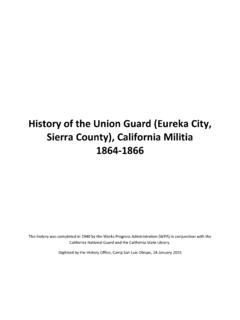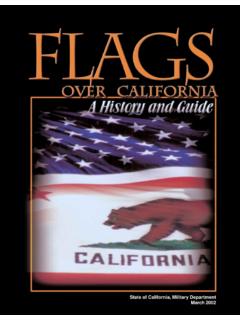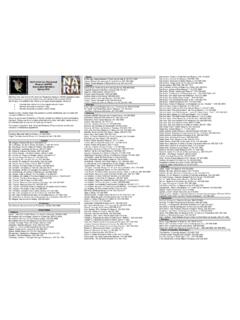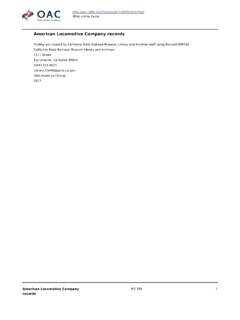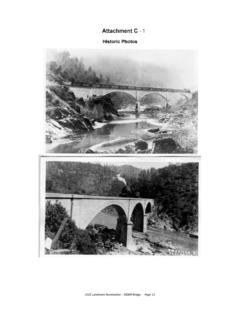Transcription of History of the California National Guard during the 1894 ...
1 History of the California National Guard during the 1894 railroad Strike This History was completed in 1940 by the Works Progress Administration (WPA) in conjunction with the California National Guard and the California State Library. Digitized by the History Office, Camp San Luis Obispo, 10 February 2015 Original document on file at the California State Library ) /~t681 ~0 ~~IHl8 GVOB1 IVH ~Hl Gtvf ' GHVQD 1 VNOilVN VINHO~I1VO n Q ---,..THE railroad STRIKE IN California The effects of the strike were felt more keenly in this State than in the Eastern states probably because of its isolation, its entire dependence on the railroads for transportation, and the fact that the strike took place at a time when the fruit crop was ready for shipment and depended on rapid transporta-tion to Eastern markets.
2 The first railroad to be affected was the Santa Fe system extending south to the Gulf and west to the Pacific Ocean, and on the twenty-eighth of June, Eugene V. Debs, President of the American Railway Union, telegraphed -oOo-1_706 V' *The Strike In California By Company B, First Infantry Regiment, Second Brigade, National Guard of California , 1895, Page 12, State Library. -2-., -----------+-,., -:t7D'r ~ from Chicago to the Pacific coast representatives of the Union to tie up the entire Southern Pacific system, thus paralyzing practically the transportation facilities of the State from the Oregon line to San Diego and from the Pacific Ocean as far East as Nevada and Arizona.
3 Fruit was ready for shipping to the markets of the East; merchants and manufacturers needed goods and supplies which could be procured only in the eastern cities; in fact a tirne could hardly be chosen when a tie up of transportation facilities would have a more disastrous affect on the State as a whole. It was the hope of the promoters of the strike to so completely paralyze all facili-ties for quick transportation both local and transcontinental, that the railroads would speedily meet the demands of the strikers and that in a very few days, business would resume its normal condition; but this was where the plans went awry.
4 The railroad officials were obstinate and instead of acceding to the demands of their employees they seemed determined to fight the matter to a finish, and as a consequence the strike lasted about three weeks. The localities in California principally affected by the strike were Los Angeles, Bakersfield, San Jose, Stockton, San Francisco, Oakland, Sacramento, Truckee, Port Costa, and Dunsmuir. Oakland was more seriously affected than San Francisco, and Los Angeles felt the effects of the strike to a greater extent than either of the two cities~ However, in none of these cities did the strike reach the importance or receive the attention it did in Sacramento; that, appearing to be the point toward which the attention of the people was directed.
5 Delayed United states mail was piling up on every hand, and it was that fact which caus d the strikers to come into conflict with 11 Uncle Sam11.* On July first, the United states took a definite stand in the matter when the United states Attorney General sent instructions to United states MA-rshals whose territory was affected by the strike, to execute the processes -oOo-v *The Strike In California rrecond Brigade, National By Company B, First Infantry Regiment, Guard of California , 1895, Page 15, State Library. -3-,__.
6 ,.. ---------------of the courts and prevent any hindrance to the free-circulation of the mails. Barry Baldwin, United states Marshal for the northern district of California , was at Sacramento with a large number of deputies sworn in for the occasion, as the group of strikers at Sacramento was larger, more deterinined and better organized than at any other place in the State. On the third of July, Baldwin attempted to open up the blockade. Strikers calmly watched the making up of trains and then at a given signal rushed forward, and in a few minutes demolished t he result of several hours' labor.
7 The Marshal was thrown to the ground sever~l times, as he rushed among the strikers in a vain effort to proceed with his plans to get the mail trains under way. F'inally realizine t he hopelessness of the situation he withdrew, leaving the depot in possession of the strikers and that same afternoon he made formal request upon Govl!rnor Mark-ham for military assistance in forcing and maintaining a free passage for the United states Mail. A plan had been arranged between the United states Marshal for the southern district of California and Marshal Baldwin of the northern district, to break almost simultaneously the blockade at Los Angeles and Sacramento.
8 Marshal Baldwin vrith his deputies was to act in conjunction with the troops of the National Guard at Sacramento, while the United states Marshal for the southern district co-operated with the troops of t he Regular United states Army at Los Angeles. The United states Marshal for the southern district had made a request upon General T. H. Ruger, co~nanding the Western Division of the United states Army for assistance at Los Angeles, and six companies of Regulars (320 men)under command of ~olonel Shafter were dispatched from San Francisco to the southern city at 10:30 , July second.
9 * The Regular troops experienced little diffi-culty in the south and without meeting any serious resistance took possession of all railroad property in Los Angeles. At Sacramento, however, the strikers, evidently encouraged by their success in resisting the efforts of Marshal Baldwin to open up a passage for the mails, were not so easily persuaded to vacate the railroad depot and yards.*-l!-In compliance with the request of the Marshal for military assistance, Governor -oOo-*The Strike in California By Company B, First Infantry Regiment, Second Brigade, National Guard of California , 1895, page 15, State Library.
10 **Adjutant General Report 1893-1894, page 211. -4-s-,_ .,..,.. ~ Markham, on the third of July ordered Major General Dimond of the National Guard of California , to send troops to Sacramento to aid in quelling the disturbance there. Realizing the of the situation, General Dimond had as early as June thirtieth begun preparations for the move-ment of troops, and subsequent developments proved the value of his foresight. The experiences of Eastern Militia in strike troubles shov1ed that the display of a large force had a s alutary effect, and for that reason it was deemed advisable to call out a large force on thl3 occasion.
